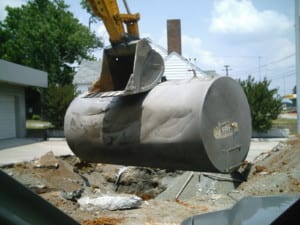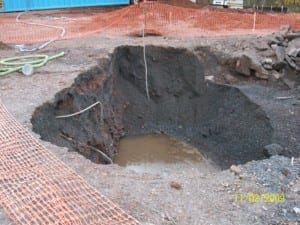How to remove an underground storage tank
 Do you have an unused underground storage tank on your property? Are you worried about the potential of a leak coming from the tank? Do you wonder if the presence of a tank will reduce the value of your property? We have fielded hundreds of similar questions about the underground storage tank removal process, the potential environmental hazards posed by the underground storage tank (UST), and the dangers of improperly removing a UST. In this article, we will discuss the general process of proper UST removal and compliance with regulatory reporting requirements.
Do you have an unused underground storage tank on your property? Are you worried about the potential of a leak coming from the tank? Do you wonder if the presence of a tank will reduce the value of your property? We have fielded hundreds of similar questions about the underground storage tank removal process, the potential environmental hazards posed by the underground storage tank (UST), and the dangers of improperly removing a UST. In this article, we will discuss the general process of proper UST removal and compliance with regulatory reporting requirements.
Unused USTs are rarely–if ever–completely emptied. As a tank deteriorates it may begin to leak the remaining fluids and pose a significant environmental liability. Therefore, it is important to remove any unused underground storage tank. Inherent dangers associated with the removal process and the potential for releasing contamination into the environment have prompted state and federal regulatory agencies to promulgate regulations and licensing requirements to ensure proper tank removal procedures are followed.
The typical underground storage tank removal process consists of the following steps:
Notify State and Local Governments
State and local governments must be given proper notification of the plan to remove the UST at least 30 days prior to any action. Local municipalities may also require some permitting.
Find a Licensed Contractor
Required qualifications for the contractor vary on a state-by-state basis. Many states require the contractor to be licensed or certified in order to perform these procedures. By enlisting the service of a licensed contractor, you are ensuring that all proper permits are obtained and all environmental regulations and safety guidelines are met before any excavation begins.
Remove All Product From the Tanks
Any residual materials must be removed from the tank. Proper disposal procedures must be followed because the waste may be considered flammable and/or hazardous.
Inert the Tank
Inerting the tank mitigates the risk of an explosive situation. The oxygen in the tank is displaced with another non-explosive gas, such as nitrogen or carbon dioxide.
Begin Excavation
The soil around the tank must be removed to gain access to the top of the tank and any associated product lines or dispensers.
Tank is Cleaned and Removed
Requirements are in place for each step of the tank cleaning and waste handling process. They cover planning for containment of small spills from piping disconnection, inerting the tank, cleaning the tank (if performed on site), handling of tank liquid and sludge, excavation, identification and proper stockpiling of uncontaminated and contaminated soil, and tank system removal.
On occasion, it is possible for tanks to be abandoned in place. For example, if the UST is beneath the foundation of a building or if it is determined that excavation will compromise the structure of a building, the state regulatory agency will give a variance to do a closure-in-place. This process typically involves the same steps: inert and enter tank, clean it in-place, and requirements for soil sampling beneath or through the tank. After sampling, the tank is filled with an inert, solid, non-shrinking material such as concrete slurry or polyfoam.
Prepare Tank for Disposal
These activities may involve such tasks as recognizing safety hazards, vapor mitigation, disposal of residual material product, disposal of accumulated sludge from the UST system, and cleaning of the UST system. Some municipalities require the tank to be cut up on site while on other occasions the tank may be transported generally intact.
Management of Contaminated Soils
During removal of UST system, it is possible that contaminated soil may be encountered. The contaminated soil must be handled and disposed according to state and/or Federal guidelines.
Follow Sampling Protocol
State guidelines require that once the tank is removed, soil samples are collected from beneath the tank (or tanks), product delivery lines, and dispensers. Each state has specific guidelines for the number and location of samples, as well as analytical requirements. If there is groundwater in the excavation, water samples must also be collected.
UST Closure Report
Different states have different requirements for reporting. The typical components of a closure report include the analytical information from soil and groundwater samples, disposal documentation of UST system components, documentation of any soil disposal, and a map showing where the samples were taken.
The analytical results for soil and groundwater samples must meet or be lower than action levels. If any results are above action levels, the state regulatory agency will require additional subsurface investigation.
Removal of Abandoned USTs Reduces Risk and Increases Property Value
Neglecting to remove an unused underground storage tank presents a risk for contamination of surrounding soil and nearby groundwater. Regulations set forth by the Environmental Protection Agency (EPA) and by state programs are designed to ensure UST removal procedures follow appropriate safety measures and protocols are observed to mitigate the risk of releasing hazardous substances that can be harmful to human and environmental health.
It is important to retain the UST removal records. Due diligence during commercial property sales transactions will raise questions regarding underground tanks. Proper and well-documented tank closure reports allow the transactions to proceed much more rapidly and reduce the likelihood of expensive investigation and remediation requirements that could adversely impact the value of the property.
EMS has conducted hundreds of underground storage tank removals. Our professional geologists and engineers will ensure your property stays in compliance with intricate state requirements while mitigating the risk of future contamination throughout the entire underground storage tank removal process. If you have any further questions regarding the underground storage tank removal process or would like to discuss how EMS can help you, please contact us!

Check out our other articles about underground storage tanks:
How Much Will a Leaking Underground Storage Tank Cleanup Cost?
The 10 Most Common Ways Underground Storage Tank Leaks are Discovered



You made a good point when you talked about the importance of making sure that the oil tank removal service that you’re interested in is going to be done by a licensed contractor to give you an assurance that all proper permits are going to be obtained for your project. There’s an unused underground storage tank in my mother’s house which we’re looking to remove to prevent it from causing environmental problems. It’s important for us to make sure that the oil tank removal process is going to be done properly and based on industry standard, so it will make sense for us to only deal with oil tank removal company that’s authorized to the job.